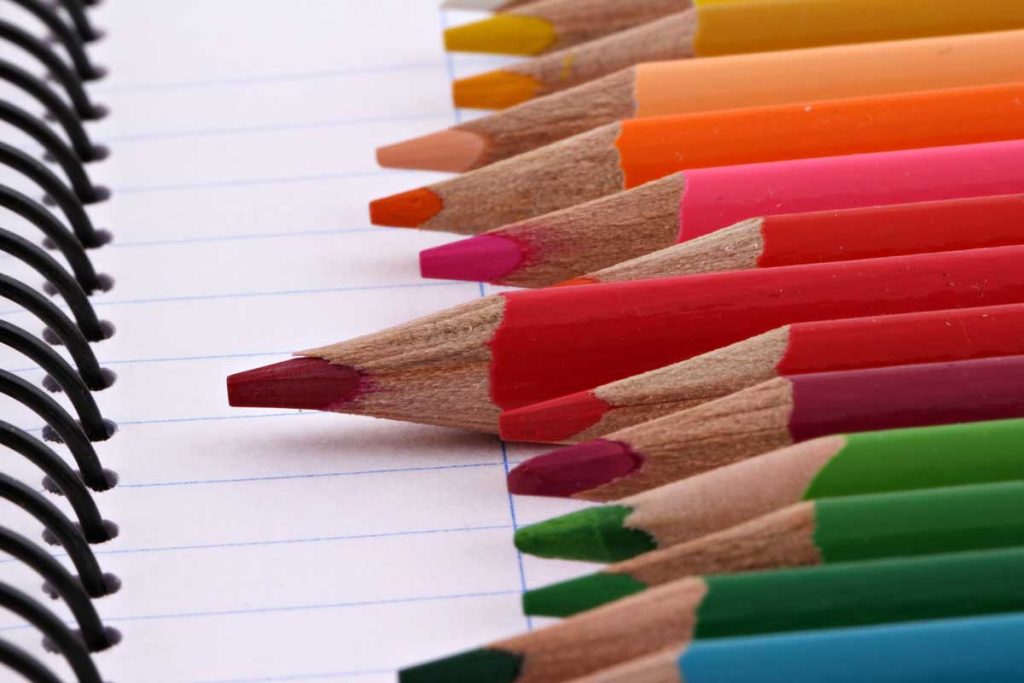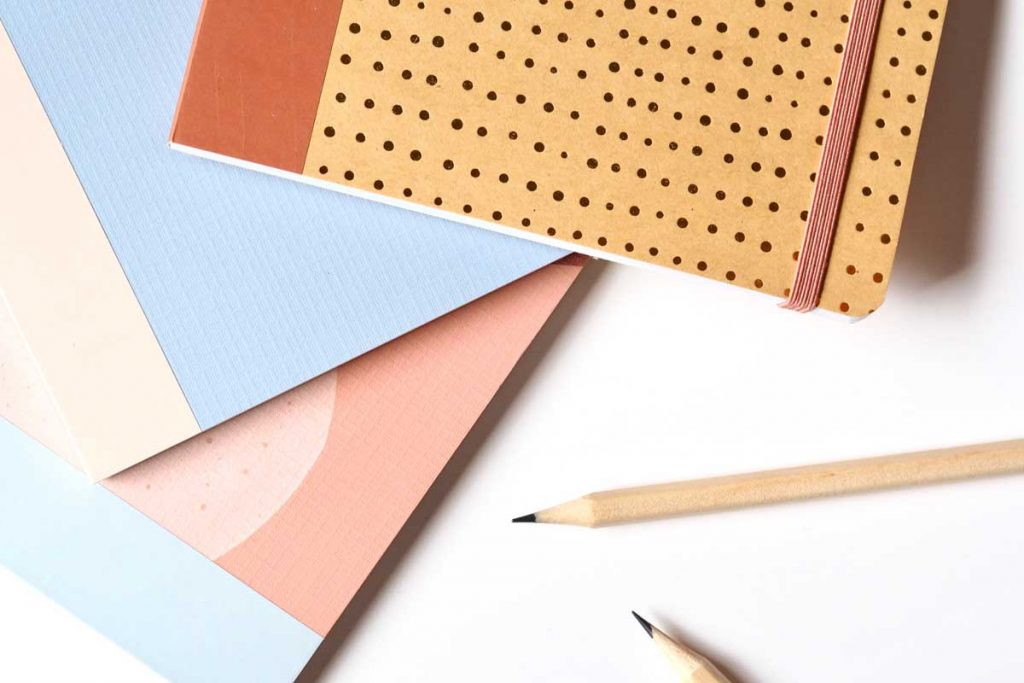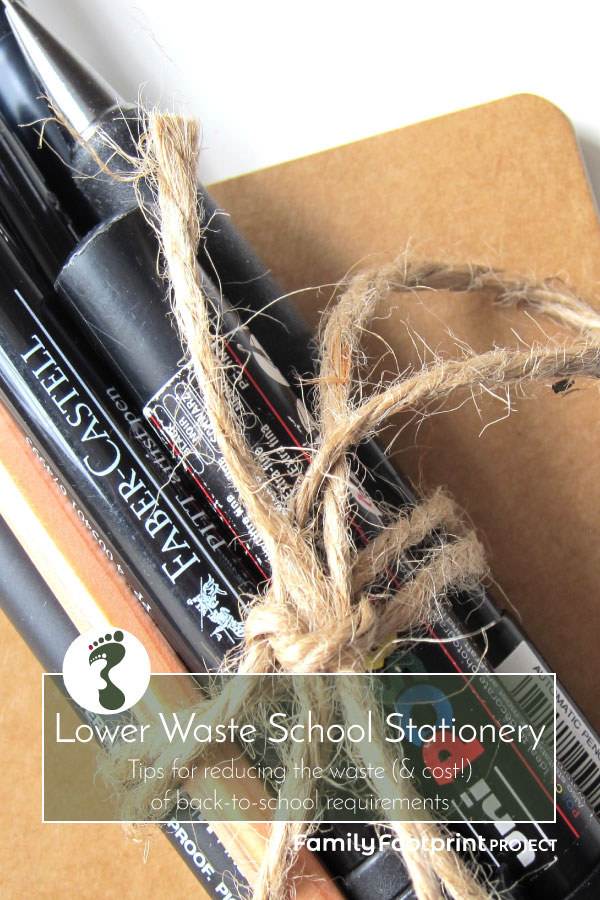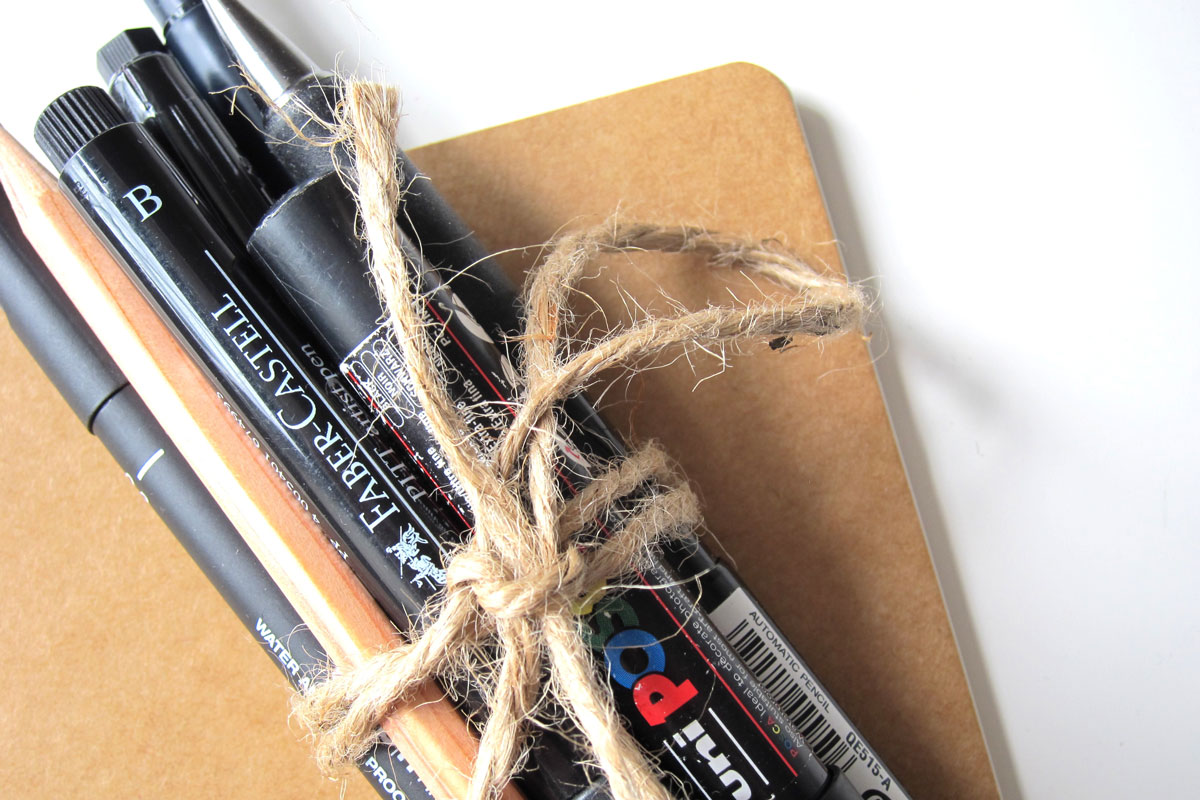It is school stationery list time and, if you are becoming a more conscious consumer, you are probably looking for lower waste school stationery options.
The school stationery list has been a thorn in my side ever since my children started primary school over ten years ago. For the first one starting Kindy, I dutifully bought the whole list as requested. At the end if that year, however, I was horrified by the waste. Exercise books with only a few pages used. Handwriting primers which were enthusiastically started in Week 1 and, it seemed, not touched again. Folders returned empty. Multiple half-used glue sticks. I’m sure you’ve been there too.
And, before the year was even over, the list for the next year was sent home with requests to buy it all over again. Oh no, no, no! There has to be a better way, a cheaper and lower waste way to deal with back-to-school requirements.
Well, there IS a better way. I’m going to share my tips from eleven years (so far) of setting up my three kids for school each year (on the stationery front anyway).
Don’t Buy The List
Schools, at least in my experience, make it seem like you have to buy from the stationery list they provide and from the supplier they choose. You don’t have to! And you almost certainly won’t need to buy everything they prescribe, so – don’t buy the list!
Certainly, make sure your kids have what they need but don’t waste your money and the Earth’s resources on buying everything new, every year. Here, as in all footprint lowering areas, look to the waste reducing principles of REFUSE, REDUSE, REUSE, ROT, RECYCLE.
Scrutinise The List
First of all, question anything that seems over the top. This is where REFUSE comes in.
This year I was asked to buy for both my boys, who are in Year 7 and Year 9, a pair of headphones with microphone for NAPLAN. This was on the ‘necessary’ list for Years 7 & 9 and on the ‘optional’ list for Years 8 & 10. I was horrified! I wrote to the principal and asked whether this was, indeed, ‘necessary’ and, if it was, that a more environmentally sustainable way of providing them be found. To his credit, his reply was that he was also concerned about the waste and that any pair of headphones with a microphone would be suitable. So I did not buy them. But can you imagine how many people did? And how long do you think those headphones lasted in the school bag of those Year 7 and Year 9 kids?
So scrutinise the list and, if necessary, ask questions of the school. Encourage them to provide more sustainable options.
Reuse Items
It may be obvious but it is worth mentioning, REUSE items that are still usable. As lovely as it is to have a new set of coloured pencils, it isn’t necessary. The half used pencil works just as well as the new pencil!
Don’t buy next year’s stationery until this year’s comes home in the last week of school so you can do a stocktake and see what it is you actually need to obtain.
Also look for general stationery from around the house. Collect everything, such as pens and pencils, into one spot and use the excess supply to stock school pencil cases.
General Tips
Seek out secondhand options. Ask in your ‘Buy Nothing‘ group for specific items or shop secondhand stores first. They often have lightly used stationery items.
If you have to buy new items, look for durable, plastic free options such as wooden or metal rulers and sharpeners. If things can be composted (ROT) at the end of their life, all the better.
Only buy a portion of the consumables up front. Top up later in the year if necessary. In primary school, let the teacher know that you are trying to reduce waste and to let you know if he or she sees your child is running low on something.
I my experience, high school & college teachers don’t really care what brand, type or amount of stationery your child has so long as they have something to write on and something to write with!
My final general tip is to label everything right down to each pencil. Things will still disappear but they have a greater chance of coming home again at the end of the year if they have your child’s name on them.

Lower Waste School Stationery Ideas
Some lower waste alternatives are more expensive than those available in office supply stores or from the stationery list supplier. By buying less, looking for secondhand items and reusing what you have, you will save a lot of money and, I believe, the higher cost of the more sustainable options will be recouped.
Here are some ideas for lower waste school stationery alternatives.
Lead Pencils & Pens
Search out lead pencils made with sustainable timber and plastic free pens. At home I like to use pens with a replaceable cartridge (like my old Parker pen) but, as these tend to be expensive, I don’t send my kids to school with them. In recent years, they have taken the pens that enviably turn up as promotional freebies, supplies bought in prior years or the mountain of pens collected from my parent-in-law’s house when we cleaned it out. If I have to buy new, I will buy plastic free pens such as those with FSC certified wood, bamboo or recycled paper casings such as sold by BuyEcoGreen.
Keep in mind that Officeworks is now starting to collect used pens & markers for recycling so don’t throw away those old dried up ones.
Coloured Pencils & Markers
Each year, I just replace the colours that are missing from coloured pencil and marker sets. Single colours are available at office supply stores or buy a new packet and supplement from that.
Again, when buying new, look for plastic free options.
Exercise Books & Folders
Some of the exercise books requested for young school children can be quite specific. Teachers request particular line configurations for children learning to write. As a former kindergarten teacher, I understand the reasons for this. It does, however, make it difficult to buy them from anywhere other than the specified supplier. Just use your judgment and buy the minimum necessary. I would love for schools to buy these in bulk and hand them out only when needed.
For regular exercise books, look for ones with recycled paper and no plastic cover. And don’t cover them with plastic.
I suggest buying smaller (e.g. 48 page) books so they have a greater chance of filling them and they can start a new one when they need to. Perhaps start the year with a slightly bigger one and give them smaller ones later in the year. If you buy ‘binder books’, the kind with holes punched in them, they can be stored together in a folder if necessary.
There is also no need to cover books in plastic. If decoration is desired, use paper, preferably recycled and recyclable. I find the weak point for books is the pages detach from the cover so the argument that plastic covering makes them more durable falls apart here (pardon the pun!)
Another low waste option, perhaps better for older kids, is to buy loose leaf paper and put it in a binder (preferably a cardboard or secondhand one). There will be no wasted pages this way. I’m not sure this would work well for my boys who are always just screwing up their handouts and throwing them into the bottom of their bags. I cannot image them keeping loose leaf paper organised.
Many schools ask for plastic sleeve folders, although aside from band and portfolios, I’m yet to really see why. In our experience, the cheaper plastic sleeve folders with the plastic comb binding break very readily in my children’s school bags. I’m still coming up with a really workable, lower plastic solution (after all they are plastic sleeve folders). Recently I bought, for band music, a folder without the comb binding to see how that stands up with the rigours of my son’s school bag.
Another option might be a cardboard ring binder with plastic sleeves inserted but I suspect this would not be a durable enough solution for my boys.

Sharpeners & Erasers
Buy durable metal sharpeners. Hopefully they don’t get lost and can be used year after year. Some teachers like them to have an inbuilt receptacle for collecting the waste but in my experience these break quickly in any case. Encourage sharpening over a bin or, better still, compost bin.
Tip: Pencil shavings are compostable. Encourage your schools to have a compost (many do nowadays) and educate their teachers and students to tip shavings into the compost.
Buy only PVC free erasers due to the environmental and health risk that the phthalates pose. Natural rubber erasers are ideal. There are also recycled rubber erasers available. I’ve only seen them on eBay so far but hopefully they will become more widely available.
Fancy erasers are sometimes included as party favours. Once again, REUSE anything that might come your way.
Scissors & Glue Sticks
Hopefully a quality pair of scissors will be used year after year. They can be cleaned and even sharpened if necessary. Label them clearly and in a ‘durable’ manner (I’ve used a piece of cotton tape tied around the finger holes with their name written in permanent marker before) and hopefully they will come home again!
Glue sticks are a tough one as they come in a plastic tube and your child will likely not thank you for sending them with a homemade pot of paste – although this would be a very sustainable option. Instead, look for recycled plastic tubes such as those sold by BuyEcoGreen.
Communicate with your School
Whether through the P&C or directly with your child’s teacher, opening up a dialogue with the school about stationery requirements and supply is a great thing to do. Sustainability is taught in our schools so raise awareness of how school stationery can be dealt with in a lower waste, more environmentally friendly way.
I would love to see primary schools managing stationery in a different way, particularly exercise books. Often a levy is paid by parents toward photocopy paper and art supplies. Why not add to that levy and buy exercise books, and perhaps other items, to be handed out by the teacher as required?
What about having class sets of protractors and compasses? I’ve bought ‘maths sets’ for my kids several times and they come home broken up and, I suspect, rarely used.
So there you have a list of some ideas for lower waste school stationery. It is something I have spent way too many hours thinking about! I’ve also regretted the way I managed stationery as a kindergarten teacher myself, before I knew any better.
I’m sure you have some ideas to add. Comment below with your lower waste school stationery experiences and suggestions. I’d love to create a great resource for us all to use year after year!
[mc4wp_form id=”96″]


